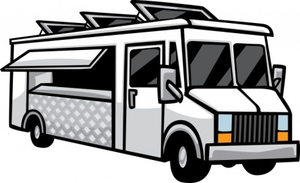 With well over a billion users, Facebook must easily rank as most people’s “where I see interesting stories and click” tool of choice. Sure, us nerds might point to Feedly or Flipboard, but that’s not “most people.” That’s the enlightened. Some of us get our favorite sites to our inbox. But that’s more rare than not.
With well over a billion users, Facebook must easily rank as most people’s “where I see interesting stories and click” tool of choice. Sure, us nerds might point to Feedly or Flipboard, but that’s not “most people.” That’s the enlightened. Some of us get our favorite sites to our inbox. But that’s more rare than not.
What seems most true, however, is that hardly anyone stops by someone’s actual blog any more (or say “site” in case you bristle at the word “blog.”) If people aren’t visiting blogs directly any more, what do we do? How do we earn that attention? And what matters most in the equation.
Enter the Food Truck
Let’s look at the analogy. A food truck goes to where the people are and delivers food. It’s lightweight, and people like the variety. A food truck is not a restaurant. People headed to a restaurant aren’t likely to change their mind and say, “Hey, let’s just eat this food truck instead,” or vice versa.
Gone are the days of “let’s all go to Chris’s blog!” Holy cats. Back in the way old days, that’s the only way people knew how to (cough twice) monetize their blog. Trust me, people of earth: almost no one comes to your site, and when they do, precious few click the ads in your sidebar. Precious few. So should you even have a site?
People Quit Their Blogs Every Day for Facebook, Medium, Extra Small, etc
I read an “I’m quitting my blog” post every few days. Always by accident. Why do I care if you quit? More potential readers for me.
“But wait, Chris. I quit my blog because I’m on Facebook, with a million users!”
Let’s Get Back to The Food Truck Analogy
Content is food. Most food trucks create their food or prep it at a “home base” and then take it to where they’ll prepare it and sell it to people: “the community you serve,” in this case.
Content = Food.
Audience/Community = Customers.
Digital Outposts = Food Truck.
Audience/Community = Customers.
Digital Outposts = Food Truck.
You’ve got to prep your food somewhere (your primary site), and then you’ve got to distribute it somewhere via your truck: Facebook, Pinterest, Instagram, Podcasts, whatever. And every time you do that, you can prep a bit, but you’ve got to serve fresh flavors to those various food truck customers, not just copy/paste content because seeing your “leftovers” all over the place is pretty boring.
Set Up Your Content
In the world of “food truck” content, you’ve got to make your posts easier to eat on the go. Shorter. You can tell me long form is the wave of the future, and I’ll show you that it’s not. No one’s reading it. This post is too long. The only long form that works is if you give out a lot of value and if you give people lots of action they can take.
In a food truck world, make yours stand out. Pictures, graphics, something extra and flavorful is what will make your food truck stand out. There are many variations: amazing service, some added bonus, some flair, “stickers.” Who knows? There are lots of ways to make your content more interesting. Instagram would help. Add some kind of value to what you’re offering.
Deliver. Configure your content so that it can be consumed at the outposts like Facebook or LinkedIn or wherever, and then gently invite them back to the home base to take whatever that next-action is for your project.
Remember what I love to say: Content marketing is weaponized storytelling. Without some intention of a next action, it’s content, not content marketing. (Tweetable)
Here’s the most important food truck part:
Make “versions” for different audiences for key pieces of content.
If you’re going to market it on Pinterest or Instagram, make a special graphic (I use Picmonkey. If you’re going to post to Facebook, pull a specific segment out and “pull quote” it there (just a way to highlight the information). Ditto with a different experience for LinkedIn. On Twitter, consider posting a graphic along with the link, maybe something different than the cover graphic.
To view the original article Click Here

No comments:
Post a Comment